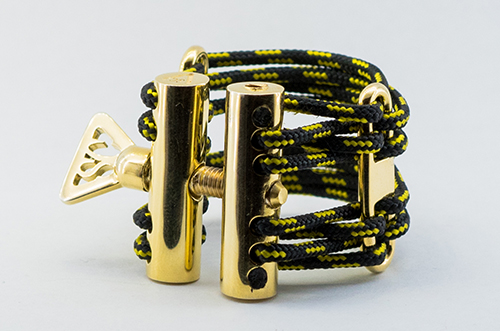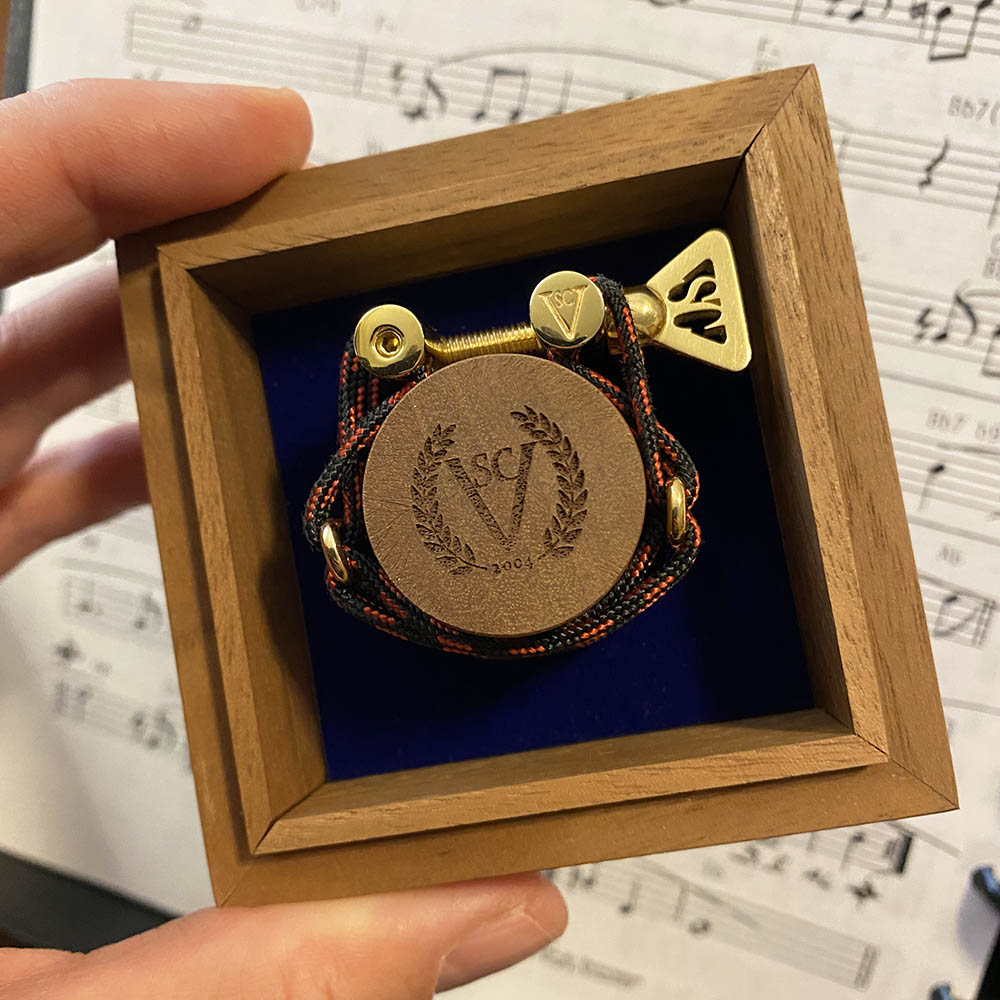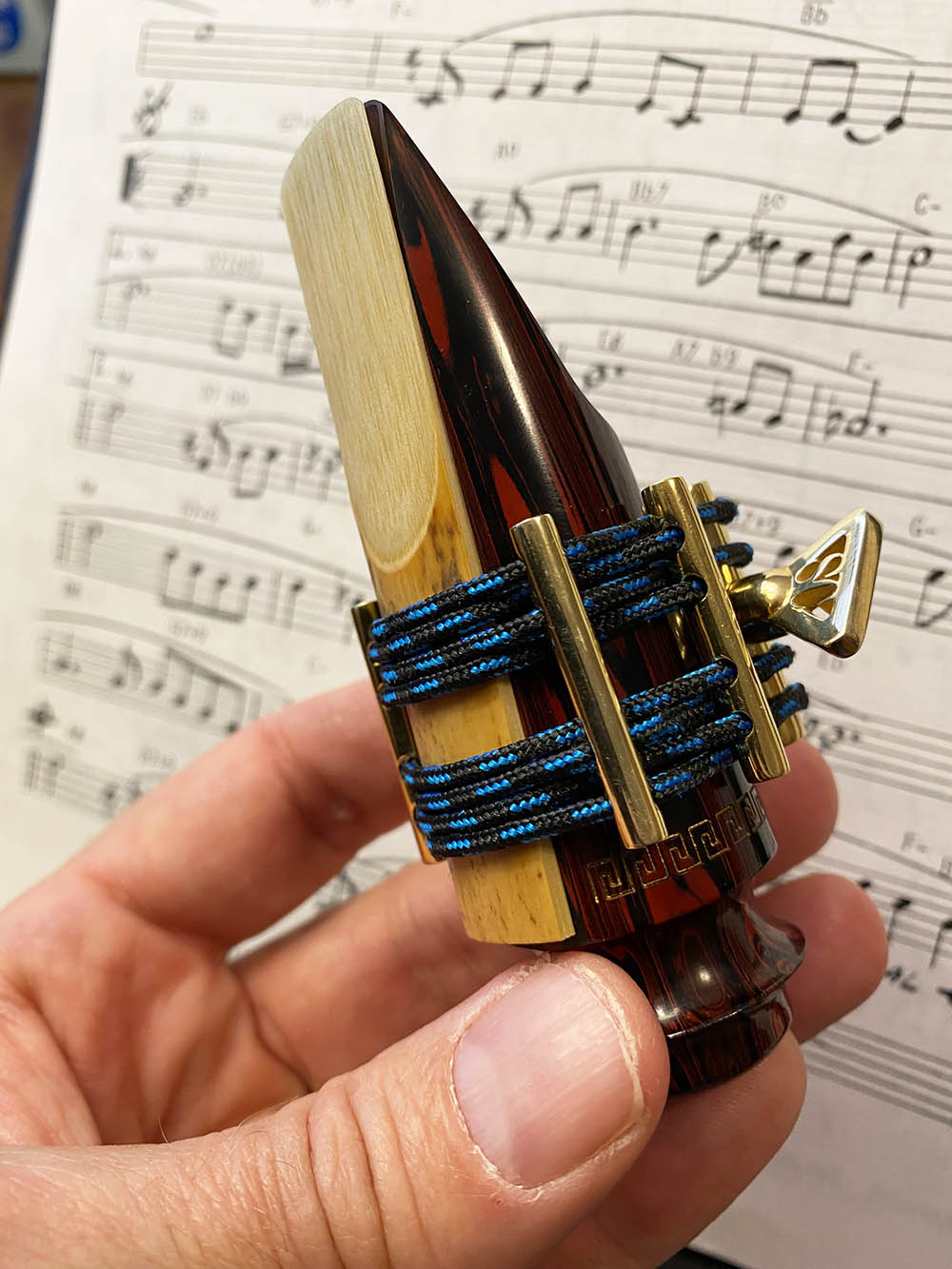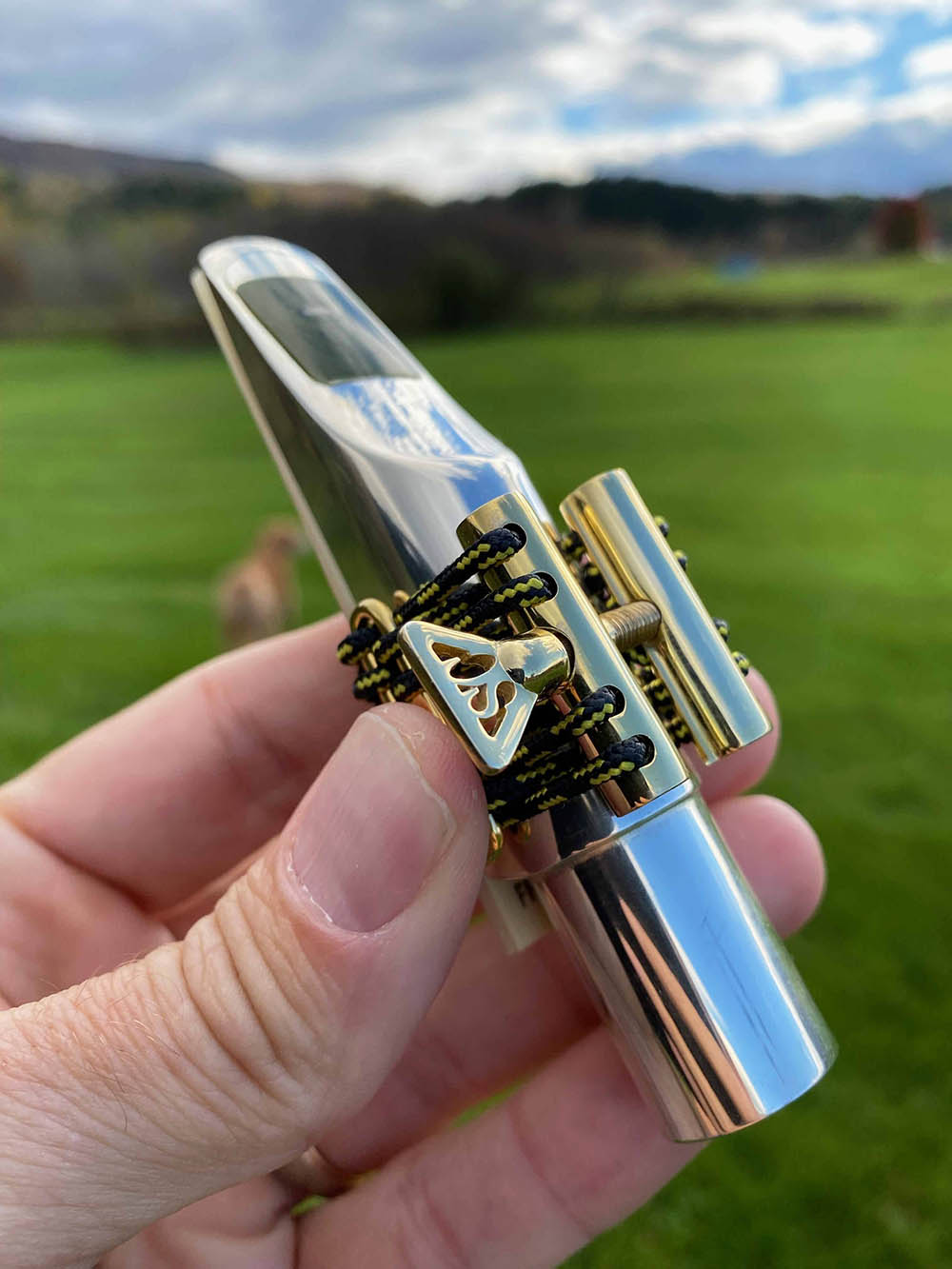Today, I am reviewing a couple of great new quality saxophone ligatures that I received from the Sax Clinic in North Macedonia. The Sax Clinic sent me a Sonus Divinus and Tonus Mundi model ligature for hard rubber tenor saxophone mouthpieces and a Sonus Divinus model ligature for Guardala sized metal tenor saxophone mouthpieces. I have been using these ligatures for a number of months before reviewing them as I wanted to be sure of their quality and durability before reviewing them.
Sax Clinic SCV Tonus Mundi Saxophone Ligature
The Sax Clinic SCV Tonus Mundi saxophone ligature (photo above) is a string ligature with two adjustable bars on either side of the ligature. Here is a quote from the Sax Clinic website describing the SCV Tonus Mundi ligature:
The ligature is comprised of a mechanism for adjustment with laterally placed four moveable guides through which the cord moves easily. The guides ensure appropriate distance and the orientation of the cord. The sound with this ligature is more compact, focused, rich and smooth creating large resonance and a wide range of sound colors. The benefits of the Tonus Mundi ligature are listed as:
-Brass material and ceramic film
-Warmer tones
-Centered projection
-Locked-in intonation
-Free-floating
-Enhanced harmonics
-Maximized reed vibration
-Fuller and rounder sound
-Easy to set up
-Fast and Precise Response
-Secure grip to prevent slipping, when quickly changing mouthpieces
-Does not create scratches on the mouthpiece
Sax Clinic SCV Sonus Divinus Saxophone Ligature
The Sax Clinic SCV Sonus Divinus ligature (photo above) has a fixed metal piece on both sides of the ligature that is not adjustable. Both Sax Clinic ligatures have an excellent design in that when the correct size is chosen for a particular mouthpiece, it is impossible for any of the metal parts of the ligature to come in contact with the mouthpiece and scratch it. Both ligatures are designed so that the cords of the ligature are always against the mouthpiece and reed at all times. Here is a description about the Sonus Divinus ligature from the Sax Clinic website:
“The ligature is comprised of a mechanism for adjustment with laterally placed two fixed guides through which the cord moves. The guides ensure appropriate distance and the orientation of the cord. With this ligature the reed vibrates in total freedom, producing a very flexible sound and a greater ease of expression and articulation. The benefits of the Sonus Divinus ligature are listed as:
-Brass material and ceramic film
-Warmer tones
-Easy response
-Locked-in intonation
-Free-floating
-Maximized reed vibration
-Stronger Projection
-Easy to set up
-Enhanced harmonics
-Equalizing the registers
-Dark, rich, focused, versatile
-Secure grip to prevent slipping, when quickly changing mouthpieces
-Does not create scratches on the mouthpiece
Sax Clinic SCV Tonus Mundi and Sonus Divinus Saxophone Ligature
The Sax Clinic ligatures come in a pretty fancy walnut wood box lined with felt that keeps the ligature well protected during shipping and makes opening the package pretty exciting. I felt like a women getting her engagement ring in the mail!
The ligatures look and feel well designed, sturdy and durable. There are no loose parts or cords hanging off the ligature that need to be tied or worried about. The cords travel through the two bars at the top of the ligature and I don’t actually see where the cords start or end in the design. I don’t see any way that the cords could dislodge or separate from the metal ligature mechanism. The ligature cords feel very strong, thick and sturdy to the touch.
Sax Clinic SCV Sonus Divinus Saxophone Ligature in it’s Walnut Wood Case
I mentioned above that I wanted to use these ligatures for a few months to test their quality and durability before writing the review. My main concern was my fear that the cords of the ligature would stretch over time and repeated tightening of the ligature. I have been using them now for about 6 months and the ligature cords have not stretched at all that I can tell. I am very impressed with the quality and design of these Sax Clinic ligatures! Here is quote from the Sax Clinic website:
“Sax Clinic SCV ligatures are made with non-stretching cord, avoiding any contact of the mouthpiece with the metal elements of the ligature that leads to minimizing undesirable vibrations between the mouthpiece and the reed. Usage of these ligatures provide warmer tones, stronger projection and better responsiveness during register changes. The ligatures provide the musicians with an opportunity to explore a broad tonal spectrum that will help them deliver their finest performance.”
Sax Clinic SCV Sonus Divinus Saxophone Ligature on a Hard Rubber Otto Link
Above, is a photo of the Sonus Divinus (size M) on a hard rubber Otto Link. The ligature slides on easily with no contact except the cords on the mouthpiece and reed. The ligature tightens easily by turning the screw at the top of the ligature. It is hard to judge how much tightness and tension is on the reed by how easily the screw twists. What I found helpful, is to loosely tighten the ligature and then test to see if the reed will move with pressure from my finger. I found that, many times, I didn’t have to tighten down the ligature as much as I thought I did to hold the reed firmly on the mouthpiece. I have found that the looser the ligature tension, while still holding the reed firmly, usually gives me the best reed response and results. I tend to not like the reed response when a ligature is over tightened. When that happens, it feels and sound like the reed is dampened and choked in response and tone to me.
The down side of using minimum tightness on the reed like I describe above is that the ligature is then more prone to slip and slide when adjusting your mouthpiece. The method that works best for me has been to tighten the ligature tight enough that it will not move on the mouthpiece, and then put it on my saxophone neck. Once it is on securely, I tune up and then once I have found the best spot for intonation on the cork, I loosen the ligature gradually until I feel like it has the best response and biggest sound. If I have to move the mouthpiece again for intonation, I can tighten the ligature tighter, move the mouthpiece and then loosen the ligature again. It is really easy to loosen or tighten the screw, even while playing, as it is a one screw mechanism.
Sax Clinic SCV Tonus Mundi Saxophone Ligature on a Alexander Superial I Jazz Tenor Sax Mouthpiece
Above, is a photo of the Tonus Mundi ligature (Size M) for hard rubber tenor saxophone mouthpieces. This has the sliding metal rods on either side of the ligature. Although I did experiment with sliding the rods to different positions, it was hard to judge if this actually made a difference because every time I loosened and tightened the ligature it was probably at a slightly different tension on the reed.
I did play test and compare the Tonus Mundi ligature for hard rubber tenor sax mouthpieces with the Sonus Divinus ligature for hard rubber tenor sax mouthpieces. It is hard to have a definitive opinion because the tension and tightness when comparing the two ligatures might be different but my observations were that the Tonus Mundi seemed to have a richer more complex tone when used and the Sonus Divinus was more free blowing and a little brighter. Those were my impressions when play testing them. I will admit that I doubt I could hear these perceived differences in tone if I took a blind listening test but those were my impressions while playing the two ligatures side by side.
I also want to add that a couple of times when I was using my metal Vandoren Optimum tenor sax ligature for a review, I took it off and put the Sax Clinic Tonus Mundi on and the improvement in tone was very noticeable. Actually, I was working on an upcoming mouthpiece review for the Alexander Superial I Jazz tenor sax mouthpiece when this happened. I was so struck by the improvement in richness of tone that I recorded the sound clip for that review with the Sax Clinic ligature instead of the Vandoren Optimum ligature like I had planned on. (That review will be posted shortly)
Sax Clinic SCV Sonus Divinus Saxophone Ligature on a Hard Rubber Otto Link
Notice in the photo above, that nothing contacts the reed except the cords of the ligature. The thought behind this design of creating a cord ligature is not new as clarinet players have been tying their own cord and string ligatures for decades. The idea is that while the cord can hold the reed firmly, there is still a bit more vibrational flexibility to the material than there would be to a metal ligature or metal plate on the reed.
Sax Clinic SCV Sonus Divinus Saxophone Ligature on a Hard Rubber Otto Link (notice there is plenty of clearance between the tightening screw and mouthpiece body on top)
In the photo above, you can see that there is ample space between the tightening screw and the mouthpiece body. I can’t even tell you how many mouthpiece bodies I have scratched and gouged by being careless with a Rovner ligature’s tightening screw over the years! The tightening screw position is designed by Sax Clinic to be at a safe distance from the mouthpiece body so that the mouthpiece does not get scratched.
Sax Clinic SCV Tonus Mundi Saxophone Ligature on a Alexander Superial I Tenor Sax Mouthpiece (I love the blue ligature color against the red marble)
As of the writing of this review, Sax Clinic does not have a ligature option for metal Otto Link tenor sax mouthpieces because of the elevated ridge on the top of metal Otto Link mouthpieces. This was a major bummer to hear as I know that many tenor sax players have a favorite metal Otto Link (if not a bunch of them) in their case or drawers. I was hoping that Vladimir at Sax Clinic would come up with a solution so that these Sax Clinic ligatures would work on a metal Otto Link mouthpiece but so far they haven’t been able to find a solution. I certainly hope they do as I think these ligatures would be killer on a metal Otto Link tenor mouthpiece.
Sax Clinic SCV Sonus Divinus Saxophone Ligature on a Liu Shizhao Pilgrimage Tenor Saxophone Mouthpiece
Above, is the Sax Clinic Sonus Divinus model ligature (size S) that fits small metal tenor sax mouthpieces that are about the diameter of a Guardala tenor sax mouthpiece. This ligature fit my Liu Shizhao Pilgrimage tenor sax mouthpiece perfectly and is designed to protect the metal of the mouthpiece by only allowing the cords to contact the mouthpiece.
Sax Clinic SCV Tonus Mundi and Sonus Divinus Saxophone Ligature on a Liu Shizhao Pilgrimage Tenor Saxophone Mouthpiece
The other detail about these ligatures that I really like is the colors. The ligatures come in your choice of red, blue, green or yellow. I don’t know, maybe it is the pandemic, but these bright and vibrant colors just bring a little bit more joy to my life as I use them, but that is just me.
The Sax Clinic SCV ligatures are quality ligatures that are easy to use and do the job of holding the reed on a mouthpiece in a reliable way. I love the way they look and their positive effects on my saxophone tone in comparison to other ligatures I have compared them to so far. These are great ligatures!
Sax Clinic SCV Tonus Mundi and Sonus Divinus Saxophone Ligature
If you are interested in trying a Sax Clinic Tonus Mundi or Sonus Divinus ligature you can order one from the Sax Clinic website. Sax Clinic has agreed to take 10% off the price of their ligatures to my readers when you use the coupon code ahduugny. I will add that Vladimir at Sax Clinic has been exceptional at communicating and patient with me during this 6 month period. He has sent me two packages during that time that arrived as expected from Macedonia and his customer service is excellent. If you have questions on sizing or anything else related to the ligatures, feel free to contact Vladimir through the Sax Clinic website.
If you try a Sax Clinic ligature or have any questions or thoughts pertaining to this review, feel free to leave a comment below. I hope you find this review helpful, Steve
Addition: Two weeks after posting this review, I decided to post a couple of sound clips to compare the sound of the Sax Clinic Tonus Mundi ligature with my favorite Francois Louis Ultimate ligature for hard rubber tenor sax mouthpieces. Both clips were recorded standing in the same spot with the same reed that was held firmly in place while I changed ligatures between clips. I was surprised by the results.
Below is a photo of a representation of the sound clips from a program called Amadeus. The sound waves to the left of the blue line are the Francois Louis Ultimate ligature and the sound waves to the right of the blue line are the Sax Clinic Tonus Mundi ligature.
I thought I was playing the exact same volume but that the Tonus Mundi ligature made the reed more vibrant and richer sounding. It does look like the photo below from Amadeus backs this impression of mine up, which I thought was interesting. The one variable besides my playing between this comparison is how tight each ligature was on the reed which I have no way of judging. Check out the comparison sound clips below and let me know if you can hear a difference.
A Photo of the sound clips next to each other on Amadeus. The first clip to the left of the blue line is the Francois Louis Ultimate Ligature and the second clip to the right of the blue line is the Sax Clinic Tonus Mundi Ligature
Early Babbitt Otto Link HR 7* Tenor Saxophone Mouthpiece-Francois Louis Ultimate Ligature
Early Babbitt Otto Link HR 7* Tenor Saxophone Mouthpiece-Sax Clinic Tonus Mundi Ligature















You mentioned that Vlado doesn’t advise using his ligatures on Otto Link metal pieces because of the ridge on top but I do have a few of his ligatures and I use them on metal Otto Links all the time. The ligature clears the ridge well and besides the ropes getting squeezed on the ridge I don’t see a downfall as they are very sturdy. He is overly cautious and it is a credit to his integrity as he would sacrifice the whole Otto Link market for a problem that may never occur. I think it is perhaps the best ligature I have seen so far on the market.
I agree. It’s a very well made and works great! Do you happen to know what size you use on a metal Otto Link mouthpiece?
Hi Steve, I was in contact with Vlado. All the Links from new NY, Florida, Tone Master and on will fit with the M for metal tenor ligature. My reproductions, Ring, Florida, will fit the S for metal tenor.
Thanks Sakshama. That is good to know. I appreciate you sharing your knowledge with us……. Steve
So… this just looks like a Silverstein copy, right? You don’t seem to mention anything about the Silverstein, whether it’s a comparison or just a comment. Is there a reason for that? Has Silverstein gone out of business or something?
Ian, If you look at photos of the Silverstein ligature side by side with these photos, you will see the design is totally different. The adjustment screws are totally different. The method and design of how the cords are held is totally different. Even the cords look different to my eyes. The only thing I see that is similar is that they are both string ligatures. I didn’t mention the Silverstein because I didn’t see the relevance of mentioning it. Silverstein is still in business as far as I know.
Hi Steve and Ian. I’m a Silverstein endorsing artist, and this does look quite similar in my opinion. I’d love to read / listen to a comparison between this ligature and a Silverstein. Any chance of that happening? Thanks!
Hi Tim, It’s similar in that it is a string ligature but the design looks totally different if you compare photos side by side. I have no plans to do a comparison review just because I already reviewed the Silverstein ligature years ago and had to send that reviewed ligature back to Silverstein. If I had one in my drawer to use I might be tempted to do a comparison but I don’t and don’t plan on buying one any time soon. If you end up trying a Sax Clinic ligature in the future and have any thoughts on how it compares to the Silverstein please let us know. Thanks, Steve
Thanks for such a quick reply. If you ever change your mind about doing a comparison, I’d highly recommend the titanium model of Silverstein. I was a skeptic at first, but material DOES make a difference, at least for me. Any plans on doing a review of the HR Ambika? Thanks again!
Thanks! Will keep that in mind about the titanium. No plans for the HR Ambika right now. I have to finished up about a dozen more mouthpiece reviews that are sitting on my desk before I can think about future reviews.
what about for Clarinet???
Yes, they make them for clarinet mouthpieces as well if you go to the Sax Clinic website.
I’m really disappointed. Mine arrived today and there is no way the medium alto they sent will fit a Meyer type mouthpiece. I see your picture with it on a link, but there’s no way mine fits even without a reed and with the screw barely engaged. I don’t know if they made a mistake. The box is marked medium but there no way this will fit. Maybe I’ll try it on a soprano piece tomorrow. An expensive mistake.
Sorry to hear that Jeff. It sounds like they sent you the wrong size perhaps? I wonder if they would send you an M if that is what you ordered and they sent something else by mistake? Try reaching out to them. Steve
Part of the issue is resolved. I mixed up the tenor and alto ligs when I took them out of the boxes. The alto will fit, albeit snugly. The tenor is now too small. The adjustment screw thread will scratch. I’ll see if is workable on my soprano. I suggested they add actual dimensions for the sizes to their sizing chart to help get the right size for mouthpieces not listed on their chart.
What two did you get? Alto Meyer size and metal tenor or HR tenor? I know when I first got them I thought the HR tenor ligature was too snug but after using it a few times, it fits perfectly. The screws come no where near the body though. I don’t see how yours would come close to the body of your mouthpiece as the metal bars touch the body and the screw is in the middle of the bars. Or are you saying the ligature is too small to even slide on the body of the mouthpiece. You’re not trying to use it on a metal Otto Link with the ridge are you?
Hey Steve,
Being a naturally bright player, I went for the Tonus Mundi, based on your review. Couldn’t be happier, thanks! I got the exact dimensions of my Syos signature piece, sent them to Vlad and he made a ligature that fits my piece perfectly. In my experience, most ligs have minimal impact on sound and response. Prior to this one, the only two that really made a difference for me were the Olegature and the Silverstein. The Tonus Mundi tops them all for me. It’s very much just “out of the way,” almost as if there’s no ligature at all, just a reed vibrating freely on the mouthpiece, giving you maximum options in terms of the reed and mouthpiece working together for whatever subtle nuance you want, unencumbered by anything else. So thanks again for the enlightening review, and a new level of enjoyment playing my horn.
I was curious about the price difference between the very expensive Silverstein and this model from Vlad. This looks to be a much better value for the money. Thanks
Hi,
Im clarinetist from Croatia but I also teach saxophone. Im using Vlado’s ligature on both clarinet and alto sax. I compared them to few Silverstein ligatures and I have to say Sax Clinic ligatures are much better, sound is more complex and everything just resonates more. Im using Tonus mundi, as you said in review its more rich in sound.
Best regards,
Nenad
I’ve been using Sax Clinic ligatures about 3 years. I agree with everything you said in your review. I can add that the design allows the cords to self-adjust between mouthpieces, so the tension stays even. I really like that as well as how easy the ligature is to use (one screw with even tension) between mouthpieces. I’ve not found a ligature as good.
I’ve noticed occasional reed slippage when I adjusted the mouthpiece with my hand on the ligature. If the mouthpiece/cork connection isn’t too tight, I adjust the mouthpiece at the base to avoid slippage. Also, when assembling, I put the mouthpiece on the cork before attaching the reed with the ligature. Doing things that way, I almost never have a slippage issue.